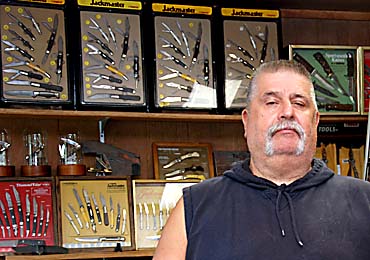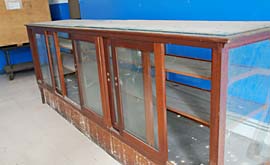Serving the Towns of Wawarsing, Crawford, Mamakating, Rochester and Shawangunk, and everything in between | |||
| |||
|
An Astonishing Collection of Automatic Knives
WALLKILL – Richard Langston's world is absolutely filled with knives. Indeed, in his house on a quiet street in the hamlet of Wallkill, memories of New York's once great knife industry are cherished and kept alive. There, in rooms crowded with display cases, Langston has one of the world's greatest collections of knives that has ever been assembled. So large is the collection that he has built a personal museum building out behind the house, with full security system to boot.
He also plans to exhibit much of his astonishing collection at the planned knife museum in Napanoch. (see sidebar) For anyone interested in the history of folding knives, automatic knives or "switchblades" this is wonderful news. Langston is the author of "The Collector's Guide to Switchblade Knives" (Paladin Press 2001) which is the definitive book on the subject. He has been collecting knives since he was eight years old, back in the 1950s. Today, he is retired after serving twenty-six years in the New York State Prison system, where he attained the rank of lieutenant. Langston's collection covers the history of the folding knife industry in our region. "Walden was once called the Little Sheffield of America," he explains. "There were three knife companies in Walden in the 19th century, and they produced about 80 percent of the knives used in America in those days." Langston notes that cutlers, the skilled knife makers, were famously independent workers. "You had to apprentice for twenty years to become a cutler. Then you worked for twenty to thirty years and you had your own apprentices. With your skills you could afford to quit any job and get another one right away." This tendency led to skilled cutlers leaving England for greater opportunity in America. Then to leaving Connecticut to set up shop in Matewan (now Beacon), New York. Then, with the aid of the townsfolk of Walden, they moved to Walden. "Folks from Walden went over to Matewan in their wagons to help bring the cutlers over." They hadn't finished their travels, however. In 1870, some Walden cutlers upped and moved over the Shawangunks to Ellenville and started the Ulster Co-op, which later became the Ulster Knife Company. For several decades several knife companies operated between Walden and Ellenville. However, change was coming to the industry.
Schrade broke the power of the independent cutlers by mechanizing the making of knives. Instead of a skilled cutler making a handful of knife patterns, Schrade used unskilled workers operating from templates to make all kinds of knife patterns. "In one hundred years, Schrade never had a union," says Langston. "The use of the templates did away with the cutler and apprentice system." In his home museum, Langston has not only an almost endless series of knife displays, but also an array of rare and unobtainable items, such as the tang stamps from Schrade, scrimshaws and the Schrade hallmark hammer. "When Schrade was going out of business, I was over there, and I made sure that somebody got them and preserved them." Schrade moved to Ellenvile in 1956 and became a mainstay of the local economy there until it closed in 2004. Langston says, "I helped out at Schrade as Curator and Antiquarian, and I went to product shows for them on the East Coast." "My own interest in knives began when my family moved to Walden when I was eight. Every day I crossed the bridge over the river and looked down at the ruins of the New York Knife Company and wondered about what had gone on there. Then I started collecting." While he was working on his book about switchblade knives, Langston also took up the task of getting legislation from Albany to allow automatic knives to be displayed for the public. Decades of grandstanding by politicians had produced laws in New York that made it technically illegal to display such knives. "It was ridiculous," growls Langston. "These were everyday tools for people, and this industry was a major part of New York history." "It took eight years to get the law passed," says Langston with a sigh. "That's Albany." Assisting in the passage of bill 423-A were Senator Bill Larkin and Assemblywoman Aileen Gunther. Signing it into law was then Governor, Eliot Spitzer. Asked how many knives he has now, Langston shakes his head. "No idea, honestly, it's gone beyond counting." Knives continue to be added to the collection too. Langston points out a recent addition. A slim, rather delicate knife with silvery sides. "It's a gentleman's pocket knife, and has hardly been used. That came in just a few days ago." He is also looking forward to the opening of the knife museum in Ellenville, and to selecting interesting items from his vast collection to show to the public.
Copyright © 2011, Electric Valley Media LLC | Terms of Use
All Rights Reserved. |
  
|




